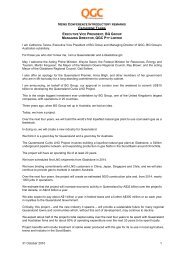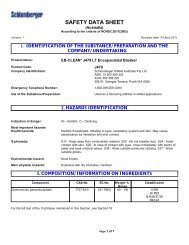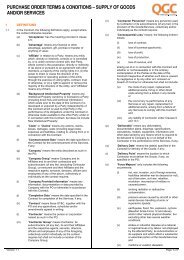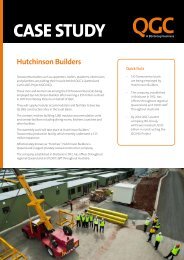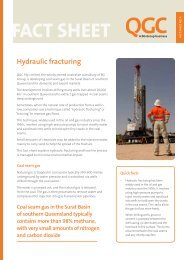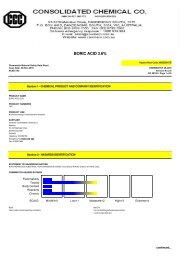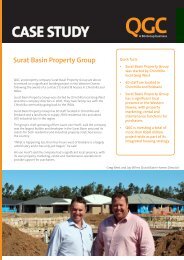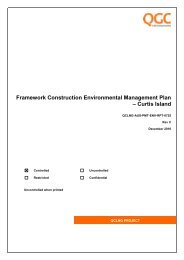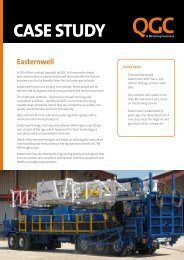Pest and Weed Management Plan - QGC
Pest and Weed Management Plan - QGC
Pest and Weed Management Plan - QGC
You also want an ePaper? Increase the reach of your titles
YUMPU automatically turns print PDFs into web optimized ePapers that Google loves.
<strong>Pest</strong> <strong>and</strong> <strong>Weed</strong> <strong>Management</strong> <strong>Plan</strong>Rev 0May 20113.3.3 <strong>Weed</strong> Hygiene DeclarationUnder the LP Act, it is an offence to supply a thing that is contaminated with a Class 1 or Class 2 weed.For Class 2 weeds, however, there is an exemption: A person does not breach the Act if they provide awritten notice that states that the thing is or may be contaminated with a Class 2 weed <strong>and</strong> h<strong>and</strong>s out thiswritten notice to the receiver before the thing is supplied. “Written notice” in the sense of the Act is the<strong>Weed</strong> Hygiene Declaration (Appendix 5). This notice has to be filled out by the supplier prior to enteringthe property <strong>and</strong> contains information about the type of equipment that is supplied or transported <strong>and</strong> itscontamination status. Machinery, such as vehicles, is considered clean when no soil or organic matterthat may contain weeds or weed seeds is attached to the machinery.The <strong>Weed</strong> Hygiene Declaration provides information on two separate activities, Part 1- Sale or supply ofthings <strong>and</strong> Part 2 - Transport of contaminated things. Part 1 should be completed if a new vehicle istransported to a sensitive area or the purchase of materials (organic matter) requires proof of weed freesupply for example in rehabilitation or earthworks operations. <strong>Weed</strong> Hygiene Declarations are to be keptby both the supplier <strong>and</strong> receiver for five years for these activities. Part 2 should be completed whenmachinery or persons are moving from location to location or in <strong>QGC</strong> case, property to property. If thethings is deemed to be contaminated, the receiver can either refuse the thing or take precautions toprevent new weed infestations. Failure to supply a written notice can incur a penalty of up to $40 000.3.3.4 <strong>Weed</strong> Hygiene Inspection Report<strong>QGC</strong> provides a company internal <strong>Weed</strong> Hygiene Inspection Report as a supplement to the <strong>Weed</strong>Hygiene Declaration Form (Appendix 6). The <strong>Weed</strong> Hygiene Inspection Report itemises the cleaned <strong>and</strong>inspected locations in detail <strong>and</strong> gives comprehensive information about the vehicle/machinery. It isrecommended because it ensures proof of process <strong>and</strong> due diligence in the weed managementprocedure. The form provides evidence for future reference should a situation relating to the spread ofweeds arise to acknowledge the steps taken on weed control (<strong>QGC</strong> Environmental Guideline: <strong>Weed</strong>Hygiene for Vehicles <strong>and</strong> Machinery. OPS-T-GDL-00002, Rev B February 2011).The Hygiene Inspection Report can only be signed by an inspector who has been trained <strong>and</strong> deemedcompetent by successfully completing the courses RTD2312A <strong>and</strong> RTD2313A provided by GreeningAustralia <strong>and</strong> other organisations. Authorised Vehicle Inspectors can be <strong>QGC</strong> or third party contractors.Third party certifications are currently conducted under certain circumstances such as cases wherel<strong>and</strong>holders raise significant concerns.The following table provides information on authorised third party weed inspectors current at the time ofreport preparation (Table 2). For further information please contact the providers directly.20 of 100



